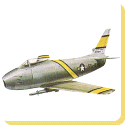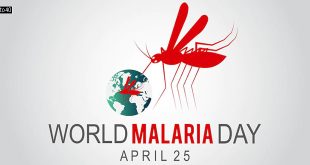 F-86 Sabre — The North American F-86 Sabre (sometimes called the Sabrejet) was a transonic jet fighter aircraft. Produced by North American Aviation, the Sabre is best known as America’s first swept wing fighter which could counter the similarly-winged Soviet MiG-15 in high speed dogfights over the skies of the Korean War. Considered one of the best and most important fighter aircraft in the Korean War, the F-86 is also rated highly in comparison with fighters of other eras. Although it was developed in the late 1940s and was outdated by the end of the 1950s, the Sabre proved versatile and adaptable, and continued as a front-line fighter in numerous air forces until the last active operational examples were retired by the Bolivian Air Force in 1994.
F-86 Sabre — The North American F-86 Sabre (sometimes called the Sabrejet) was a transonic jet fighter aircraft. Produced by North American Aviation, the Sabre is best known as America’s first swept wing fighter which could counter the similarly-winged Soviet MiG-15 in high speed dogfights over the skies of the Korean War. Considered one of the best and most important fighter aircraft in the Korean War, the F-86 is also rated highly in comparison with fighters of other eras. Although it was developed in the late 1940s and was outdated by the end of the 1950s, the Sabre proved versatile and adaptable, and continued as a front-line fighter in numerous air forces until the last active operational examples were retired by the Bolivian Air Force in 1994.
Its success led to an extended production run of more than 7,800 aircraft between 1949 and 1956, in the United States, Japan and Italy. Variants were built in Canada and Australia. The Canadair Sabre added another 1,815 airframes, and the significantly redesigned CAC Sabre (sometimes known as the Avon Sabre or CAC CA-27), had a production run of 112. It was by far the most-produced Western jet fighter, with total production of all variants at 9,860 units.
Development
North American had produced the highly successful propeller-powered P-51 Mustang in WWII which saw combat against some of the first operational jet fighters. By late 1944, North American proposed its first jet fighter to the US Navy which became the FJ-1 Fury. It was an unexceptional transitional jet fighter which had a straight wing derived from the P-51. Initial proposals to meet a United States Army Air Forces (USAAF) requirement for a medium-range, single-seat, high-altitude jet-powered day escort fighter/fighter bomber were drafted in mid-1944. In early 1945, North American Aviation submitted four designs. The USAAF selected one design over the others, and granted North American a contract to build three examples of the XP-86 (eXperimental Pursuit), By deleting specific requirements from the FJ-1 Fury, coupled with other modifications, this allowed the XP-86 to be lighter and considerably faster than the Fury, with an estimated top speed of 582 mph (937 km/h), versus the Fury’s 547 mph (880 km/h). Despite the gain in speed, early studies revealed the XP-86 would have the same performance as its rivals, the XP-80 and XP-84. It was also feared that, because these designs were more advanced in their development stages, the XP-86 would be canceled.
Crucially, the XP-86 would not be able to meet the required top-speed of 600 mph (970 km/h); North American had to quickly come up with a radical change that could leapfrog over its rivals. The North American F-86 Sabre was the first American aircraft to take advantage of flight research data seized from the German aerodynamicists at the end of the war. This data showed that a thin swept wing could greatly reduce drag and delay compressibility problems which had bedeviled even prop-powered fighters such as the Lockheed P-38 Lightning as fighter speeds approached the speed of sound. By 1944, German engineers and designers had established the benefits of swept wings based on experimental designs dating back to 1940. Study of the data showed that a swept wing would solve their speed problem, while a slat on the wing’s leading edge which extended at low speeds would enhance low-speed stability.
Because development of the XP-86 had reached an advanced stage, the idea of changing the sweep of the wing was met with resistance from some senior North American staff. Despite stiff opposition, after good test results were obtained in wind tunnel tests, the swept-wing concept was eventually adopted. Performance requirements were met by incorporating a 35° swept-back wing, using NACA 4-digit modified airfoils, using NACA 0009.5-64 at the root and NACA 0008.5-64 at the tip. with an automatic slat design based on that of the Me 262 and an adjustable stabilizer. It should be noted that many Sabres had the “6-3 wing” (a fixed-leading edge with 6 inches extended chord at the root and 3 inches extended chord at the tip) retrofitted after combat experience was gained in Korea. This modification changed the wing airfoils to the NACA 0009-64 mod at the root and the NACA 0008.1-64 mod at the tip.
Delays caused by the major redesign meant that manufacturing did not begin until after World War II. The XP-86 prototype, which would lead to the F-86 Sabre, was rolled out on 8 August 1947. At the controls of George Welch, the maiden flight occurred on 1 October 1947 from Muroc Dry Lake (now Edwards AFB), California.
The United States Air Force’s Strategic Air Command had F-86 Sabres in service from 1949 through 1950. The F-86s were assigned to the 22nd Bomb Wing, the 1st Fighter Wing and the 1st Fighter Interceptor Wing. The F-86 was the primary U.S. Air Combat Fighter during the Korean War, with significant numbers of the first three production models seeing combat.
The F-86 Sabre was also produced under license by Canadair, Ltd., in the Province of Quebec as the Canadair Sabre. The final variant of the Canadian Sabre, the Mark 6, is generally rated as having the highest capabilities of any Sabre version made anywhere. The last Sabre to be manufactured by Canadair (Sabre #1815) is now kept in the Western Canada Aviation Museum’s (WCAM) permanent collection in Winnipeg, Manitoba, after being donated by the Pakistan Air Force.
Design
The F-86 was produced as both a fighter-interceptor and fighter-bomber. Several variants were introduced over its production life, with improvements and different armament implemented. The XP-86 was fitted with a General Electric J35-C-3 jet engine that produced 4,000 lbf (18 kN) of thrust. This engine was built by GM’s Chevrolet division until production was turned over to Allison. The General Electric J47-GE-7 engine was used in the F-86A-1 producing a thrust of 5,200 lbf (23 kN) while the General Electric J73-GE-3 engine of the F-86H produced 9,250 lbf (41 kN) of thrust. The fighter-bomber version (F-86H) could carry up to 2,000 lb (907 kg) of bombs, including an external fuel-type tank that could carry napalm. Unguided 2.75 in (70 mm) rockets were used on some of the fighters on training missions, but 5 inch (127 mm) rockets were later carried on combat operations.
The F-86 could also be fitted with a pair of external jettisonable jet fuel tanks (four on the F-86F beginning in 1953) that extended the range of the aircraft. Both the interceptor and fighter bomber versions carried six 0.50 in (12.7 mm) M3 Browning machine guns with electrically-boosted feed in the nose (later versions of the F-86H carried four 20 mm (0.79 in) cannons instead of machine guns). Firing at a rate of 1,200 rounds per minute, the. 50 in (12.7 mm) guns were harmonized to converge at 1,000 ft (300 m) in front of the aircraft, using Armor Piercing (AP) and Armor Piercing Incendiary (API) rounds, with one Armor Piercing Incendiary Tracer (APIT) for every five AP or API rounds.
The API rounds used during the Korean War contained magnesium, which were designed to ignite upon impact but burned poorly above 35,000 ft (11,000 m) as oxygen levels were insufficient to sustain combustion at that height. Initial planes were fitted with the Mark 18 manual-ranging computing gun sight. The last 24 F-86A-5-Nas and F-86E were equipped with the A-1CM gunsight-AN/APG-30 radar which used radar to automatically compute the range of a target. This would later prove to be a significant advantage against MiG opponents over Korea.
 Kids Portal For Parents India Kids Network
Kids Portal For Parents India Kids Network
